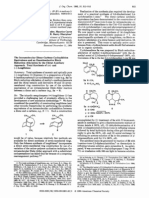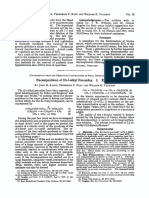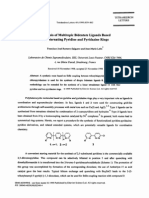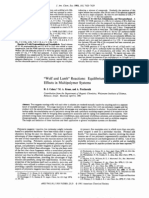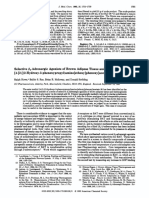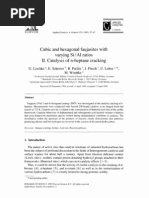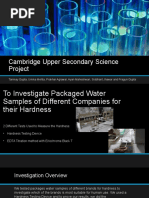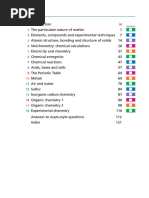Katritzky 1988
Katritzky 1988
Uploaded by
bknier1Copyright:
Available Formats
Katritzky 1988
Katritzky 1988
Uploaded by
bknier1Original Title
Copyright
Available Formats
Share this document
Did you find this document useful?
Is this content inappropriate?
Copyright:
Available Formats
Katritzky 1988
Katritzky 1988
Uploaded by
bknier1Copyright:
Available Formats
192 Langmuir 1988, 4 , 192-195
systems, where octylammonium octanoate is replaced by systems is also investigated. The results may be helpful
a long-chained a l ~ o h o l . ' ~ J ~ J ~ to clarify the molecular origin of the hydration force, but
Further work is going on in our laboratory to obtain a they may also become useful for technical applications.
better understanding of the thermodynamics in different
A+A- systems. The experimental work is concentrated on Acknowledgment. Prof. Bjorn Lindman and Prof.
obtaining phase diagrams for A+A- systems with different I%kan Wennerstrom are gratefully acknowledged for many
A+ and A- head groups, but the solubility of long-chained comments and suggestions.
alcohols and other molecules in different A+A--water Registry No. Na+A-, 1984-06-1;A+A-, 17463-34-2.
Unusual Catalytic Activity of Anionic Surfactant Analogues
of 4-(Dimethy1amino)pyridinein Carboxylate Ester
Hydrolyses
Alan R. Katritzky,*t Bradley L. Duell,t Barry L. Knier, and H. Dupont Dursti
Department of Chemistry, University of Florida, Gainesville, Florida 32611, and Applied
Chemistry Branch, Chemistry Division, U S . Army Chemical Research and Development
Center, Aberdeen Proving Ground, Maryland 21010-5423
Received June 25, 1987
Anionic Surfactants containing the 4-(N,N-dialkylamino)pyridinemoiety and incorporating sulfate (2),
phosphate (31, sulfonate (51, and carboxylate (7) end groups were synthesized and tested as catalysts for
the hydrolysis of 4-nitrophenyl hexanoate (PNPH). Surfactant 2 was the most active, with kz = 38.0 M-'
s-' in the absence of added CTAC and 62.2 M-'s-' in 0.001 M CTAC. The other derivatives tested (3 and
7) were still twice as active as neutral, cationic, and zwitterionic surfactants of the same type. Possible
reasons for these rate enhancements are discussed.
Introduction
In a previous paper,' we reported studies of a series of
surfactants incorporating the 4-(N,N-dialkylamino)-
ClSOsH
pyridine moiety as catalysts of fluorophosphate and car-
(41 %)
boxylate ester hydrolyses. All the compounds displayed
catalysis of the hydrolysis of p-nitrophenyl hexanoate,
although none efficiently catalyzed that of fluoro-
phosphate. The most surprising finding was that the single
anionic derivative, sodium 10-[butyl(6pyridinyl)amino] -
decyl sulfate (2))was more active by 1order of magnitude 1. DCCINCCHpCHzOP03H2
2.NsOH 145%)
-
over neutral, cationic, and zwitterionic analogues. Com-
pound 2 catalyzed the hydrolysis at pH 8.6 of Cnitrophenyl
hexanoate with Itz = 38.0 M-'s-l, which compared favor-
ably to hydrolyses utilizing the active o-iodosobenzoate
catalysts developed by Moss and co-workers.2-4 The su-
perior activity of 2 compared to its analogues of different
I MsClINEts
(95%) 3
charge type was unexpected, since ester hydrolyses under
basic conditions, although readily enhanced by cationic
surfactants (e.g., cetyltrimethylammonium chloride
(CTAC)), are normally retarded by anionic surfactants 4 5
(e.g., sodium dodecyl ~ u l f a t e ) . ~
We have now prepared three additional related anionic
4-(dialky1amino)pyridine surfactants (3, 5, 7; Scheme I)
1 KCNIKI
(63%)
and report in the present paper their synthesis and cata-
lytic activity in the hydrolysis of PNPH, in an effort to
clarify this situation.
Synthesis 8 7
The anionic 4-(dialky1amino)pyridinesurfactants were
all synthesized from 10-[butyl(4-pyridinyl)amino]-l-de- derivative 3 was also prepared in 51% yield directly from
canol (1)' according to the plan outlined in Scheme I. 1, by DCC-catalyzed cyanoethyl phosphorylation>followed
We previously1 reported the synthesis of sulfate 2 from
alcohol 1 by reaction with chlorosulfonic acid. Phosphate (1)Katritzky, A. R.; Duell, B. L.; Durst, H . D.Langmuir, in press.
( 2 ) Moss, R. A.; Alwis, K. W.; Bizzigotti,G . 0. J.Am. Chem. SOC.1983,
105, 681.
t University of Florida. ( 3 ) Moss, R.A,; Alwis, K. W.; Shin, J.4. J.Am. Chem. SOC.1984,106,
* U.S.Army Chemical Research and Development Center. 2651.
0743-7463/88/2404-0192$01.50/0 0 1988 American Chemical Society
Surfactant Analogues of 4-(Dimethylamino)pyridine Langmuir, Vol. 4, No. 1, 1988 193
Table I. '*C NMR Chemical Shift Data ( 6 ) for 4-(Dialkylamino)pyridineAnionic Surfactants
1 2 3 4 5 6 7 8 B 1 0 11121314
::b
X--CH*CH~CH~CH~CH~CH~CH~CH~CH~CH~NCH~CH~&H~CHS
compd X solvent 1 2 3 4-7 8 9 10 11 12 13 14 2' 3' 4' X
DMAP CDC13 37.8 37.8 148.6 105.6
153.1
1 OH CDC13 62.2 32.7 25.7 29.3" 26.8 28.9 49.7b 50.0b 32.7 20.0 13.7 149.2 106.1
152.4
2 OS03H CDC13 67.2 28.7' 25.1 28.7" 26.0 28.7" 50.5b 50.7b 28.1 19.4 13.3 138.9 106.3
155.5
3 OP03Hz CDC13/CD30D 66.0 29.4 24.6 28.4" 25.8 28.4" 50.2b 50.4b 28.4" 19.1 12.8 138.2 106.3
155.5
4 OSOzMe CDCl, 70.0 28.4" 24.8 28.4" 26.1 28.4O 50.5b 50.7b 28.4" 19.4 13.3 138.5 106.2
155.5 44.7
(CH3)
5 S03H CDC13 32.8 28.4" 28.4" 28.4" 26.2 28.4" 50.7b 5O.gb 28.4" 19.4 13.3 142.1 107.7 154.2
6 CN CDClS 15.7 27.2" 23.8 27.2" 25.2 27.2" 49.7 49.7 27.2" 18.5 12.4 141.1 106.8 153.3 118.5
(CN)
7 COOH CDCl3 33.2 28.0" 23.7 28.0" 25.6 28.0" 50.3 50.3 28.0" 18.9 12.8 141.5 107.2 153.8 175.1
(COOH)
"Cluster of peaks centered at this chemical shift. These assignments are interchangeable.
by removal of the cyanoethylprotecting group with sodium Table 11. Second-Order Rate Constants @CAT) for the
hydroxide. Hydrolysis of.p -Nitrophenyl Hexanoate (PNPH) at pH 8.5
Sulfonate 5 and carboxylate 7 were prepared via mesy- ([PNPH] = 5.5 X lod M)
late 4, itself synthesized (95%) by reaction of 1with mesyl kCAT, M-' s-'
chloride in the presence of triethylamine. Treatment of compd no CTAC 1 mM CTAC 5 mM CTAC
4 with KZSO3/KIin refluxing ethanol gave 5 in 50% yield, 1 (ROH) 1.25 35.6 32.0
as the hydrochloride salt. Carboxylate 7 was synthesized 2 (ROSOSH) 38.0 62.2 35.8
by reaction of 4 with KCN/KI in refluxing ethanol to give 3 (ROPO3Hz) 2.36 10.0 9.05
6 (63%) followed by acidic hydrolysis (87% yield). 7 (RCOOH) 2.69 5.12 3.21
13CNMR data for intermediates and final compounds DMAP" 3.68 1.96 1.32
are shown in Table I (alcohol 1 and DMAP are included blank (no surfactant) b
for comparison purposes). Assignments were based upon "DMAP = 4-(dimethylamino)pyridine. Hydrolysis in the ab-
comparison to known systems. sence of surfactant gave a pseudo-first-order rate constant of 6.5 X
The chemical shifts are consistent with the structure s-l, which represents background hydrolysis (khyd + koT-
shown in Table I. Chemical shifts for pyridine carbons [OH-]). At the [PNPH] given above, this corresponds to an initial
C-2', C-3', and C-4' of 1 are essentially the same as those rate of 3.6 X lo4 M s-'. In comparison, using kc^^ for 3 at a con-
centration of 0.001 M, the initial rate was 130 X lo+' M s-'.
for DMAP. However, compounds 2-7 are hydrochloride
salts, and this difference is reflected in the 13C chemical Scheme I1
shifts of the pyridine nucleus. Carbon C-2' is shielded by
approximately 10 ppm, whereas C-4' is deshielded (by 1-3 R-N- (CH2)qo-A-
I I
ppm) and C-3' is relatively unchanged compared to 1.
Similar effects have been reported for other pyridinium
ions.'
Chemical shifts for the alkyl carbons were also as ex-
pected. Carbon C-1 resonated a t 6 62.2 in 1, a t slightly
higher values in 2-4, and farther upfield (at 6 30) in 5 and
7. In nitrile 6, C-1 occurred at 6 15.7, which, in combination
with the CN resonance a t 6 118.5, was useful as a diagnostic
tool for confirming the presence or disappearance of 6.
Carbons C-1 and C-2 of phosphate 3 were both split into
doublets, with 2J = 5.8 and 3J = 7.3 Hz, respectively, due
to 13C-31Pcoupling. + R'COOH
Kinetic Results and Discussion
The anionic surfactants were tested for catalytic activity R- N -(CH2+0-A- R - N T 6-h
in the hydrolysis of 4-nitrophenyl hexanoate (PNPH).
Catalysts 2 and 7 were utilized as free bases, and 3 as its
hydrochloride salt. Limited solubility precluded the
testing of sulfonate 5. The procedures utilized for the W
kinetics measurements were as described in a previous 9
paper.' The results are reported in Table 11, in which
values for DMAP and for alcohol 1 are included for the Surfactant 2 remains the most effective catalyst in this
purpose of comparison. whole series and is some 15 times better than 3 or 7.
However, kz values for 3 and 7 (2.36 and 2.69 M-' s-l,
respectively) were still about twice those for neutral sur-
(4) Moss,R. A.; Kim, K. Y.; Swamp, S. J. Am. Chem. SOC.1986,108, factant 1 and for the analogous cationic and zwitterionic
188.
(5)Fendler, J. H.; Fendler, E. J. Catalysis in Micellar and Macro- surfactants, synthesized previously.' The anionic head
molecular Systems; Academic: New York, 1975; pp 98-120. group thus appears to play a significant role in the catalytic
(6)Tener, G.M. J. Am. Chem. SOC.1961,83,159. activity of these systems.
(7)Levy, G. C.;Lichter, R. L.; Nelson, G. L. Carbon-13 Nuclear
Magnetic Resonance Spectroscopy, 2nd ed.; Wiley-Interscience: New The relatively high efficiency of the anionic compounds
York, 1980; p 118. a t first glance appears anomalous since, as mentioned
194 Langmuir, Vol. 4, No. 1, 1988 Katritzky et al.
above, for electrostatic reasons, anionic surfactants nor- Microanalyses were either performed in house, on a Carlo Erba
mally retard basic hydrolyses. However, other factors can 1106 elemental analyzer, or by Atlantic Microlabs, Atlanta, GA.
be invoked. Thus, anchimeric assistance of hydrolysis of Materials. Commercially available reagent grade solvents and
the 1-acylpyridinium intermediate by the anionic head reagents were used without further purification. Silica gel fil-
trations utilized either E. M. Merck or MCB silica gel 60 (230-400
group could account for the observed enhancements. mesh). 10-[Butyl(4-pyridinyl)amino]-l-decanol (1) and 10-[bu-
Electrostatic stabilization of the acylpyridinium interme- tyl(4-pyridinyl)amino]-l-decylsulfate (2) were prepared as de-
diate may also be taking place (Scheme 11). Formation
-
scribed previously.’
of acylpyridinium 8 is known to be the rate-determining l0-[Butyl(4-pyridinyl)amino]-l-decylPhosphate (3).
step in hydrolyses of the type RCOX RCOOH + HX.8 Barium (2-cyanoethy1)phosphate dihydrate (0.58 g; 1.73 mmol)
Electrostatic stabilization of the positive charge in 8 by and Amberlite IR-120 H.C.P. cation-exchange resin (sulfonic acid,
the anionic group could lower the transition-state energy 3 g) were stirred in water (5 mL) until the barium salt dissolved.
for its formation and thus increase the rate of formation The solution was passed through a column of the same resin (5
of 8. g), washing with water (15 mL). The water was removed by adding
Another important factor is the pKa values of the various dry pyridine (10 mL), evaporating, and repeating the process; a
yellow oil was obtained. To this was added 1 (0.51 g; 1.67 mmol)
groups involved. At the pH of the reaction medium (pH in dry pyridine (10mL) followed by dicyclohexylcarbodiimide
8.5),the 4-(dialky1amino)pyridinegroup (pKa = 9.4*) is (1.38 g; 6.70 mmol) and the mixture stirred at room temperature
The OS03H and COOH groups (pKa -3 and 4.8, re- -
approximately90% in the protonated form ( ~ F @ J P Y H + ) . ~
spectivelylO)should both be 100% ionized and the OP03H,
for 17 h. Water (2 mL) was added, stirring continued for 1 h,
then 10% HOAc (50 mL) was added, and the mixture was heated
on a steam bath for 2 h. The solvent was evaporated and the
moiety (pK, values of -2.1 and 7.21°) approximately 96% residue heated on the steam bath with 0.5 N NaOH (70 mL) for
in the OPO2- f0rm.l’ Thus,the dominant species present 2 h. After the mixture cooled to room temperature, the solid was
in solution are zwitterionic (9, Scheme 11). Hence, 2, 3, filtered and the filtrate acidified and evaporated (via ethanol
and 7 could act as zwitterionic “bolaform” surfactants azeotrope). The semisolid was taken up in absolute ethanol (50
(Scheme II).12J3 The surface activity of dicationic bola- mL), filtered, and evaporated. To the resulting oil was added
water (20 mL). The mixture was basified (pH 10) with 2.5 N
forms has been interpreted by the formation of “wicket- NaOH and then extracted with EtOAc (2 X 10 mL). After
like” structures a t the air-water interface.13 Such bola- acidificationof the aqueous layer, NaCl was added and the solution
forms can form micelles if the connecting carbon chain extracted with 3:2 CH2Cl2/EtOH (3 X 10 mL). The combined
length equals or exceeds 12 (Scheme 111, and these bola- extracts were dried over MgSO, and evaporated to give 0.32 g
forms are capable of increasing the rate of p-nitrophenyl (45%) of the hydrochloride of 3 as an amber oil: IR (thin film)
doodecanoate hydrolysis (by 28-fold at pH 3500-2000 (br), 3300 (br), 2930 (e), 2850 (s), 2200,2060,1730,1650
This reasoning carries with its significant implications (s), 1545 (s), 1465, 1370, 1210 (br, s), 1080-950 (br, s), 910, 730
for the surfactants synthesized in this study. The chain (s) cm-’.
lengths in compounds 2,3, and 7 connecting the anionic Anal. Calcd for C1J-13sClN204P”20: C, 51.75; H, 8.69. Found:
C, 51.43; H, 8.62.
and the cationic (PyH+)groups are roughly 15 atoms (in-
lO-[Buty1(4-pyridinyl)amino]-1-decyl Methanesulfonate
cluding N, 0, and S and counting the pyridine ring as 2 Hydrochloride (4). A solution of methanesulfonyl chloride (0.48
atoms), and this allows the chains to form bolaform mi- g; 4.20 mmol) in CHzClz(4 mL) was added dropwise over a period
celles. The formation of wickeblike species is perhaps even of 10 min to a solution of 1 (1.24 g; 4.06 mmol) in CHzClz(12 mL)
more likely with the dicationic bolaforms because of the at room temperature. After stirring 3 h, the solution was cooled
oppositely charged head groups involved. This would in ice, triethylamine (0.78 g; 7.72 mmol) and additional meth-
account for the higher catalytic activity of the “anionic” anesulfonyl chloride (0.48 g) were added in one portion, and
surfactants, since the other surfactants prepared are in- stirring was continued a t room temperature for 24 h. After
capable of forming such micelles. In solution, the “neutral” addition of CHzClz(20 mL), the mixture was washed with water
and “zwitterionic” surfactants would actually have a net (20 mL) and 1N HCl(20 mL),dried over MgS04, and evaporated
to give 1.63 g of 4 (95%) as an amber oil (4was stored in CHzClz
positive charge (+l), whereas the “cationics“ would possess in the refrigerator to prevent decomposition): IR (thin film)
an overall double positive charge (+2). 3100-2300 (br), 2930 (s), 2860 (s),1640 (s), 1590 (w), 1545 (s), 1460,
A t the present time, the reason for the high activity of 1420 (w), 1345 (s), 1210, 1170 (s), 1100 (w), 1040,970,940,930,
surfactant 2 (ROS03H) relative to 3 (ROPO,H,) and 7 810,730 cm-’; high-resolution mass spectrum ( m / e )(for free base)
(RCOOH) remains unclear. We are currently in the pro- calcd 384.2447, found 384.2469 (standard deviation 0.0053).
cess of investigating further the precise structures of the l0-[Butyl(4-pyridinyl)amino]decanesulfonicAcid Hy-
species present in solution. drochloride (5). 4 was taken up in CH2C12,washed with 1 N
NaOH, filtered through silica gel, and evaporated to give the free
base. The free base (0.24 g; 0.63 mmol), KzSO3 (0.36 g; 2.28 mmol),
Experimental Section KI (0.32 g; 1.93 mmol), and EtOH (95%; 1.5 mL) were refluxed
Methods. All melting pointa are uncorrected and were taken for 17 h. Water (10 mL) was added and the ethanol evaporated.
in open glass capillary tubes with a Thomas-Hoover melting point The solution was acidified to pH 3-4 and extracted with CHzClz
apparatus. IR spectra were obtained on a Perkin-Elmer 283B (1 X 15 mL). The organic layer was washed with 1 N HCl (10
infrared spectrophotometer. 13C NMR spectra were obtained a t mL), dried over MgS04, and evaporated to give 0.13 g (50%) of
25 MHz on a JEOL FX-100 NMR spectrometer, referenced to 5 as a yellow glass: IR (thin film) 3400 (br), 3100-2300 (br), 2920
CDC13 (6 77.0), and are reported in Table I. High-resolution mass (s), 2860 (s), 1645 (s), 1550 (s), 1465, 1420, 1370, 1230, 1190 (s),
spectra were obtained on an AEI MS30 mass spectrometer. 1110, 1030, 825, 720, 520 (br) cm-’.
Anal. Calcd for C1J-135C1Nz03S.2Hz0: C, 51.51; H, 8.87. Found
C, 51.89; H, 8.87.
(8) Scriven, E. F. V. Chem. SOC.Reu. 1983, 12, 129. ll-[Butyl(4-pyridinyl)amino]undecanenitrile Hydro-
(9) The percentage of protonated pyridine (PyH+) in a solution of Py chloride (6). 4 (0.90 g: 2.13 mmol), KCN (0.56 g; 8.62 mmol),
is given by the following; % PyH+ = {[PyH+]/([PyH*l + [Pyl)} X 100 KI (1.20 g 7.23 mmol), and EtOH (absolute; 9 mL) were refluxed
+ +
= (1 IOPH-PK+~ x io0 = (1 108.5-9.4)-1x.100 = 89%. for 17 h, at which point more EtOH (5 mL) was added and
(10) Gordon, A. J.; Ford, R. A. The Chemrst’s Companion; Wiley-In- refluxing was continued for 2 h. Water (20 mL) was added and
terscience: New York, 1972; pp 58-59. the ethanol evaporated. The mixture was basified with 2.5 N
(11) The percentage of A- in a solution of HA is given by the following:
% A- = I[A-]/([A-] + [HA])/ x 100 = (1 + 10pK*-pH)-l X 100. NaOH and extracted with CHzClz(1X 25 mL). The organic layer
(12)Fuoss, R. M.; Chu, V. F. H. J. Am. Chem. SOC.1951, 73, 949. was evaporated, and the resulting oil was taken up in CHzClz (7
(13) Menger, F. M.; Wrenn, S. J. Phys. Chem. 1974, 78, 1387. mL), washed with 1 N HC1 (7 mL), and passed through a pad
Langmuir 1988,4, 195-200 195
of silica gel (5 g), washing with 2 4 % MeOH in CHZClp Evap- with 1 N NaOH, boiling the solution with charcoal, filtering it
oration of the eluate gave 0.47 g of 6 (63%)as an amber oil: IR through silica gel with 5-15% MeOH/CH2Cl2,and evaporating
(thin film) 3420 (br), 2920 (s), 2850 (s), 2230 (w), 1640 (s), 1550 the filtrate to give a thick, colorless oil, which slowly crystallized
(s), 1460, 1420, 1365, 1185, 1100 (w), 915 (w), 820, 725 cm-'. to colorless needles. Spectra were identical with those for 7, except
Anal. Calcd for CmH34C1N3.3H20: C, 59.17; H, 9.93. Found: that the 13C NMR spectra lacked the resonance at S 175.1 and
C, 59.29; H, 8.93. the IR spectra lacked the broad adsorption at 3600-2500 cm-'
ll-[Butyl(4-pyridinyl)amino]undecanoic Acid Hydro- and possessed an additional band at 920 cm-*.
chloride (7). 6 (0.42 g; 1.19 mmol) and concentrated HCl(4 mL) Anal. Calcd for CzoHMNz02.2Hz0: C, 64.83; H, 10.34. Found
were refluxed for 15 h, then more concentrated HCl(2 mL) was C, 64.74, H, 10.16.
added, and refluxing was continued for 2 h more. After cooling Kinetics. Rate measurements were carried out utilizing p-
to room temperature, the mixture was extracted with 3:l nitrophenyl hexanoate (PNPH) by methods discussed in an earlier
CH2Cl2/MeOH(3 X 4 mL), and the extracts were dried over paper.'
MgSOl and passed through a pad of silica gel (2 g), washing with
3:l CH2Cl2/MeOH(40 mL). Evaporation of the eluate gave 0.37 Acknowledgment. We thank the Army Research Of-
g (87%)of 7 as an amber glass: IR (thin film) 3600-2500 (br), fice for financial support and Drs. Cliff Bunton and Fred
3400 (br),2960 (s),2930 (s), 1720 (s), 1650 (s), 1550 (s), 1465,1425, Menger for helpful discussions.
1370, 1190 (s), 1100 (w), 1030 (w), 820, 730 cm-'.
Anal. Calcd for C&~ClNz0z~2Hz0: C, 59.02; H, 9.66. Found Registry No. 1, 110027-37-7;2, 111823-07-5;2 (freebase),
C, 59.61; H, 9.22. 110027-38-8;3, 111823-01-9;4, 111823-02-0;5, 111823-03-1;6,
The free base (zwitterion)of 7 was utilized for rate measure- 111823-04-2;7, 111823-05-3;7 (freebase), 111823-06-4;PNPH,
menta and was prepared by washing a chloroform solution of 7 956-75-2;DMAP, 1122-58-3;NC(CH2)z0P03Hz.Ba,5015-38-3.
Study of Langmuir-Blodgett Films for KrF Excimer Laser
Resist
K. Ogawa,* H. Tamura, M. Hatada,? and T. Ishihara
Semiconductor Research Center, Matsushita Electric Ind. Co., Ltd., 3-15,Yagumo-Nakamachi,
Moriguchi, Osaka, 570 Japan, and Osaka Laboratory for Radiation Chemistry, Japan Atomic
Energy Research Institute, 25-1,Mii-Minami Machi, Neyagawa, Osaka, 572 Japan
Received March 18,1987. I n Final Form: July 28,1987
Studies in an attempt to prepare photosensitive Langmuir-Blodgett (LB) films and photochemical
reactions of LB films induced by a KrF excimer laser (EX) beam have been carried out on three fatty acids
of diacetylene derivatives (tricosadiynoicacid, pentacosadiynoic acid, and heptacosadiynoic acid), w-tri-
cocynoic acid, and octadecylacrylic acid. The patterning of the LB films was carried out by using the EX
stepper. Among five compounds, pentacosadiynoic acid gave the best result with 0.3-pm resolution on
the LB films which were prepared from Langmuir (L) films on an aqueous subphase containing mol/L
Ca2+at 25 mN/m. Spectroscopic studies on the structure of the LB film indicate that the patterning is
caused by cross-linking at 1,4 positions of diynoic groups. The resolution (0.3 pm) obtained in the present
study is determined by the resolution limit of the optical system of the EX stepper developed for this purpose,
- resolution theoretically- expected.
which is the hkheat - This technique will be useful for fabrication of 64-Mbit
D-RAMS.
Introduction is being developed for making molecular devices.a
Recent progress in semiconductor technology has re- There already are some papers studying the EB expo-
quired photolithography to perform in the 0.5-pm region; sure on LB films, i.e., by A. Barraudg and others.lOJ1 In
however, the currently available photolithography relying Barraud's paper, patterns of 600-Aline and space were
on UV or visible light has a limitation. In order to improve fabricated by using a-tricosenoic acid. But the EB expo-
the performance, several methods have been proposed,
including high NA and short wavelength type reduction- (1)Spears, D. L.; Smith, H. I. Solid State Technol. 1972,15, No. 7,
projective light exposure apparatus (stepper), direct draw 21.
electron beam (EB) exposure apparatus, X-ray exposure (2)Jain, K.; Willeon, C. G.; Lin, B. J. ZBM J. Deu. 1982,26, 151.
apparatus (X-ray stepper),' and excimer laser exposure (3) Kawamura, Y.;Tyoda, K.; Nanba, S. J. Appl. Phys. 1982,53(9),
6489.
apparatus (EX ~ t e p p e r ) . ~ - ~ (4)Pol, V.;Bennewitz, J. H.; Escher, G. C.; Feldman, M.; Firtion, V.
On the other hand, the available diameter of the wafer A.; Jewell, T. E.; Wilcomb, B. E.; Clemens, J. T. Proc. SPIE-lnt. SOC.
currently is increasing to 8 in. A technique of uniform, Opt. Eng. 1986, March 6,663-01.
(5)Orvek, K. J.; Palmer, S. R.; Garza, C. M.; Fuller, G. E. Proc.
thin coating of the resist on these wafers is needed to SPZE-Znt. SOC.Opt. Eng. 1986, March 6,631-12.
obtain patterns below 0.5 pm in the case of EX exposure (6)Blodgett, K.J. Am. Chem. SOC. 1935,57,1007.
method. The available spin coating method is no longer (7)Gaines, G. L., Jr. Insoluble Monolayers at Liquid-Gas Interface;
Interscience:, New York, 1966.
workable for this purpose. For this purpose, we can use (8) Mcalear, J. H.; Wehrung, J. M. Dig. Tech. Pap-Symp. VLSZ Tech.
the preparation method of Langmuir-Blodgett,B,' which 1981,82.
(9)Barraud, A. Thin Solid Films 1983,99, 317.
(10)Broers, A. N.; Pomerantz, M. Thin Solid Films 1983,99, 323.
Osaka Laboratory for Radiation Chemistry. (11)Fariss, G.; Lando, J.; Rickert, S. Thin Solid Films 1983,99,305.
0743-7463/88/2404-0195$01.50/0 0 1988 American Chemical Society
You might also like
- VIM Bleach Cream: Safety Data SheetDocument6 pagesVIM Bleach Cream: Safety Data SheetTuấn Anh ĐỗNo ratings yet
- Cellulose-Based Aerogels From Sugarcane Bagasse For Oil Spill-Cleaning and Heat Insulation ApplicationsDocument7 pagesCellulose-Based Aerogels From Sugarcane Bagasse For Oil Spill-Cleaning and Heat Insulation ApplicationsPhạm Ngân100% (1)
- J. Org. Chem., Vol. 36, No. 9, 1971Document2 pagesJ. Org. Chem., Vol. 36, No. 9, 1971SlapdragonxNo ratings yet
- 2007 Synthesis of 1,5-Dinitroaryl-1,4-Pentadien-3-Ones Under Ultrasound IrradiationDocument5 pages2007 Synthesis of 1,5-Dinitroaryl-1,4-Pentadien-3-Ones Under Ultrasound IrradiationJESUS DAVID BOLA‹O JIMENEZNo ratings yet
- Electronic Effect On Rhodium Diphosphine Catalyzed Hydroformylation: The Bite Angle Effect ReconsideredDocument11 pagesElectronic Effect On Rhodium Diphosphine Catalyzed Hydroformylation: The Bite Angle Effect ReconsideredXibely GonzalezNo ratings yet
- Synthesis of Chrysen PDFDocument16 pagesSynthesis of Chrysen PDFRaj SundarNo ratings yet
- Computational StudiesDocument13 pagesComputational StudiesHeLena NukaNo ratings yet
- Efficient Cyanoaromatic Photosensitizers For Singlet Oxygen Production: Synthesis and Characterization of The Transient Reactive SpeciesDocument21 pagesEfficient Cyanoaromatic Photosensitizers For Singlet Oxygen Production: Synthesis and Characterization of The Transient Reactive SpeciesemmanuNo ratings yet
- Comparison The Reactivity S - Adenylic Acid and S - Guanylic AcidDocument5 pagesComparison The Reactivity S - Adenylic Acid and S - Guanylic AcidEr Mayur PatilNo ratings yet
- Anisucoumaramide, A Bioactive Coumarin From Clausena Anisum-OlensDocument7 pagesAnisucoumaramide, A Bioactive Coumarin From Clausena Anisum-OlensAlexis CushicondorNo ratings yet
- PT (IV) - Catalyzed Hydroamination Triggered Cyclization: A Strategy To Fused Pyrrolo (1,2-A) Quinoxalines, Indolo (1,2-A) Quinoxalines, and Indolo (3,2 - C) QuinolinesDocument10 pagesPT (IV) - Catalyzed Hydroamination Triggered Cyclization: A Strategy To Fused Pyrrolo (1,2-A) Quinoxalines, Indolo (1,2-A) Quinoxalines, and Indolo (3,2 - C) QuinolinesDiogomussumNo ratings yet
- Chem202400453 Sup 0001 Misc - InformationDocument80 pagesChem202400453 Sup 0001 Misc - Information20chph14No ratings yet
- Lewis Acid Induced Nubleophilic Substitution (Heck)Document4 pagesLewis Acid Induced Nubleophilic Substitution (Heck)bemestaremacaohojeNo ratings yet
- Photochemical Studies of MarijuanaDocument3 pagesPhotochemical Studies of Marijuanabagusu_6No ratings yet
- Trans Imminazione Beta ControllataDocument2 pagesTrans Imminazione Beta ControllatafuturichimiciNo ratings yet
- Bio Org Chem Lett 2008Document4 pagesBio Org Chem Lett 2008Suman BalyaniNo ratings yet
- Synthesis MenthadienolDocument2 pagesSynthesis MenthadienolAnonymous Gb9EyW100% (1)
- Pascard1991 PerindoprilDocument7 pagesPascard1991 PerindoprilnagarajharishNo ratings yet
- 12 Ane Metal Ion ComplexesDocument9 pages12 Ane Metal Ion ComplexesSabrina MilanoNo ratings yet
- Gas ChromotagraphyDocument10 pagesGas ChromotagraphytieugiaoduNo ratings yet
- Novel Soluble and Thermally-Stable Fullerene Dyad Containing Perylene (Document5 pagesNovel Soluble and Thermally-Stable Fullerene Dyad Containing Perylene (Lodrick WangatiaNo ratings yet
- 1 s2.0 S0367326X21001957 MainDocument7 pages1 s2.0 S0367326X21001957 MainAira SaidNo ratings yet
- Jo3c02343 - Si Year 2024Document80 pagesJo3c02343 - Si Year 2024pabitrapanigrahi02No ratings yet
- Decompositions of Di-t-Alkyl Peroxides. I. Kinetics: Frederick F. EDocument7 pagesDecompositions of Di-t-Alkyl Peroxides. I. Kinetics: Frederick F. Emartinml_1191No ratings yet
- CV3P0502Document5 pagesCV3P0502narendraNo ratings yet
- Enantioselective Intermolecular (2 + 2) - Photocycloaddition Reactions of Alkenes and A 2-Quinolone in SolutionDocument2 pagesEnantioselective Intermolecular (2 + 2) - Photocycloaddition Reactions of Alkenes and A 2-Quinolone in SolutionM PadilNo ratings yet
- Reduction of a,@-UnsaturatedNitriles With A Copper Hydride ComplexDocument2 pagesReduction of a,@-UnsaturatedNitriles With A Copper Hydride Complexalchemy090909No ratings yet
- A New Neoquassin Derivative From Quassia AmaraDocument3 pagesA New Neoquassin Derivative From Quassia Amarashikhasharma_85No ratings yet
- Leuckart ReactionDocument3 pagesLeuckart ReactionKybernetikum100% (1)
- Monographie BIPM-5 Tables Vol2 PDFDocument307 pagesMonographie BIPM-5 Tables Vol2 PDFMadalina-Elena CostacheNo ratings yet
- Tetrahedron Letters Volume 40 Issue 5 1999 (Doi 10.1016/s0040-4039 (98) 02540-4) Francisco JoséRomero-Salguero Jean-Marie Lehn - Synthesis of Multitopic Bidentate Ligands Based On Alternating PyDocument4 pagesTetrahedron Letters Volume 40 Issue 5 1999 (Doi 10.1016/s0040-4039 (98) 02540-4) Francisco JoséRomero-Salguero Jean-Marie Lehn - Synthesis of Multitopic Bidentate Ligands Based On Alternating PyJoakin BahamondesNo ratings yet
- NPC Natural Product Communications: A New Benzylisoquinoline Alkaloid From Leontice AltaicaDocument2 pagesNPC Natural Product Communications: A New Benzylisoquinoline Alkaloid From Leontice AltaicaSel QnkovaNo ratings yet
- PDF Environmental Pollution Control by Cs Rao PDFDocument371 pagesPDF Environmental Pollution Control by Cs Rao PDFRanjan GandhiNo ratings yet
- Part 2-ACS Catalysis (2016), 6 (9), 6086-6090Document41 pagesPart 2-ACS Catalysis (2016), 6 (9), 6086-6090Ranjana MadabushiNo ratings yet
- $yano 3Document3 pages$yano 3ashokNo ratings yet
- Ja971400y Si 001Document14 pagesJa971400y Si 001mike van dorsselaerNo ratings yet
- Chlorination of Alcohols by Pivaloyl Chloride-DMFDocument3 pagesChlorination of Alcohols by Pivaloyl Chloride-DMFalchymystNo ratings yet
- CO2 To Methanol Supporting InformationDocument51 pagesCO2 To Methanol Supporting InformationHimadri SahaNo ratings yet
- Wolf and LambDocument10 pagesWolf and LambPrasanna IyerNo ratings yet
- ANTHONY CRASTO-Brevetoxin SynthesisDocument58 pagesANTHONY CRASTO-Brevetoxin SynthesisAnthony Melvin Crasto Ph.DNo ratings yet
- AlminoprofenDocument37 pagesAlminoprofenKyucheol PaikNo ratings yet
- 1992 J Med Chem b3 SelectivosDocument9 pages1992 J Med Chem b3 Selectivosjames mellaleievNo ratings yet
- ReductionDocument2 pagesReductionCatenaneNo ratings yet
- Chiral Sulphonated Phosphines. Part VII. Catalytic Transfer-Hydrogenation of Unsaturated Substrates With Formates in The Presence of Water Soluble Complexes of RhodaDocument4 pagesChiral Sulphonated Phosphines. Part VII. Catalytic Transfer-Hydrogenation of Unsaturated Substrates With Formates in The Presence of Water Soluble Complexes of RhodappopgodNo ratings yet
- Cubic and Hexagonal Faujasites With Varying Si/A1 Ratios II. Catalysis of N-Heptane CrackingDocument11 pagesCubic and Hexagonal Faujasites With Varying Si/A1 Ratios II. Catalysis of N-Heptane CrackingIonut BanuNo ratings yet
- Articulo Quimica Medicinal 3Document16 pagesArticulo Quimica Medicinal 3Jose Antonio Espinosa TorresNo ratings yet
- Triterpene Saponins From The Roots of Clematis ChinensisDocument6 pagesTriterpene Saponins From The Roots of Clematis ChinensisTrâm HuỳnhNo ratings yet
- Fulltext 2021 Vol 3 Is 4Document86 pagesFulltext 2021 Vol 3 Is 4Tamar KhakhutashviliNo ratings yet
- Heterocyclic Analogues Benzamide Antiarrhythmic Agents'Document6 pagesHeterocyclic Analogues Benzamide Antiarrhythmic Agents'Hadeel Al-SinjilawiNo ratings yet
- Enantioselective Synthesis of (S) - 2-Methyl-1-Alkanols Via Bakers' YeastDocument8 pagesEnantioselective Synthesis of (S) - 2-Methyl-1-Alkanols Via Bakers' YeastJuan Javier M. VegaNo ratings yet
- Sample Derivatization in Separation Science: November 2015Document32 pagesSample Derivatization in Separation Science: November 2015Salvador Valero BermejoNo ratings yet
- Protein Sequenator: P. EdmanDocument12 pagesProtein Sequenator: P. EdmanAndrés Jonathan Cepeda GuerronNo ratings yet
- NJC_46_20755Document5 pagesNJC_46_20755所同川No ratings yet
- A Mild and Efficient Route To Schiff Base Derivatives of Amino AcidsDocument4 pagesA Mild and Efficient Route To Schiff Base Derivatives of Amino AcidsAmit PaulNo ratings yet
- Properties of Amino Acids: M T, PK, PKDocument2 pagesProperties of Amino Acids: M T, PK, PKantonioNo ratings yet
- OJC - Vol33 - No3 - P - 1061-1070 PDFDocument10 pagesOJC - Vol33 - No3 - P - 1061-1070 PDFleninhauNo ratings yet
- Diazotazione NaNO2 NaHSO3Document3 pagesDiazotazione NaNO2 NaHSO3leda_prandiNo ratings yet
- Catalizador Platino y PaladioDocument11 pagesCatalizador Platino y PaladioLaura GarciaNo ratings yet
- Buchwald-Hartwig C-N Cross Coupling Reactions Catalyzed by A Pseudo-PincerDocument7 pagesBuchwald-Hartwig C-N Cross Coupling Reactions Catalyzed by A Pseudo-PincerAlberto ReyesNo ratings yet
- Carpenter 1990Document6 pagesCarpenter 1990Charan RavulaNo ratings yet
- Application of IC-MS and IC-ICP-MS in Environmental ResearchFrom EverandApplication of IC-MS and IC-ICP-MS in Environmental ResearchRajmund MichalskiNo ratings yet
- Groundwater Remediation: A Practical Guide for Environmental Engineers and ScientistsFrom EverandGroundwater Remediation: A Practical Guide for Environmental Engineers and ScientistsNo ratings yet
- OCHS5002 - Solvents Gases and VapoursDocument18 pagesOCHS5002 - Solvents Gases and Vapourstim.k.g.12No ratings yet
- Unit-4 Chromatography PDFDocument9 pagesUnit-4 Chromatography PDFhacker7899No ratings yet
- Sensors, Motors and Valves CatalogueDocument14 pagesSensors, Motors and Valves CatalogueMARCO CHELINo ratings yet
- Chapter 1Document11 pagesChapter 1jrr93906No ratings yet
- Nomenclature - Adv LevelDocument20 pagesNomenclature - Adv LevelRAZA ASLAM LOGADENo ratings yet
- Effects of Chlorinated Water On Polymeric Water Distribution SystemsDocument4 pagesEffects of Chlorinated Water On Polymeric Water Distribution SystemsJohn BundangNo ratings yet
- Combating: When Is Too MuchDocument120 pagesCombating: When Is Too MuchnehaNo ratings yet
- Reporte Diario Laboratorio Asoc Nare MayoDocument433 pagesReporte Diario Laboratorio Asoc Nare Mayooskar0911No ratings yet
- Cambridge Upper Secondary Science ProjectDocument13 pagesCambridge Upper Secondary Science ProjectSiddhant JhawarNo ratings yet
- O Shecdomelea $O: S.Nodaa O Scale Lefl Sida IayeDocument3 pagesO Shecdomelea $O: S.Nodaa O Scale Lefl Sida IayegeetishaNo ratings yet
- 5 Extraction of Caffeine v2Document10 pages5 Extraction of Caffeine v2skyeandoNo ratings yet
- 20201120-Adhesion Strength Testing For Waterproofing Overlaid by AsphaltDocument18 pages20201120-Adhesion Strength Testing For Waterproofing Overlaid by Asphalttony13touchNo ratings yet
- Colby 1997Document10 pagesColby 1997brouuorbNo ratings yet
- United States Patent: (10) Patent No .: US 9, 893, 215 B2Document9 pagesUnited States Patent: (10) Patent No .: US 9, 893, 215 B2Andrew StarkNo ratings yet
- 5070 June 2015 Paper 42 Mark Scheme PDFDocument5 pages5070 June 2015 Paper 42 Mark Scheme PDFleaNo ratings yet
- OSBORN Knot Wired Cup BrushDocument2 pagesOSBORN Knot Wired Cup BrushThái Mai ĐìnhNo ratings yet
- AM Week 2 ECM NOTESDocument19 pagesAM Week 2 ECM NOTESa38659158No ratings yet
- Redox and Electro-ChemistryDocument32 pagesRedox and Electro-ChemistryilhamsaifyhasanNo ratings yet
- Plasticization of Glassy Polymers byDocument10 pagesPlasticization of Glassy Polymers byEnam HaqNo ratings yet
- The Periodic TableDocument18 pagesThe Periodic Tablesohailnoreen5062No ratings yet
- Cambridge IGCSE Chemistry Study and Revision GuideDocument31 pagesCambridge IGCSE Chemistry Study and Revision GuideSarah HopeNo ratings yet
- Internal Energy LessonDocument4 pagesInternal Energy LessonPrincess Fenix SabioNo ratings yet
- DLP Physical and Chemical ChangeDocument7 pagesDLP Physical and Chemical Changeharvey lopegaNo ratings yet
- Materials 14 06657Document17 pagesMaterials 14 06657Alperen BozdemirNo ratings yet
- Micellar Solubilization of Poorly Water-Soluble Drugs: Effect of Surfactant and Solubilizate Molecular StructureDocument35 pagesMicellar Solubilization of Poorly Water-Soluble Drugs: Effect of Surfactant and Solubilizate Molecular StructureSami FauzanNo ratings yet
- Antimicrobial and Mite Protection in Textiles PresentationDocument43 pagesAntimicrobial and Mite Protection in Textiles Presentation20MT31 - NAAVENDHAN SNo ratings yet
- (PDF Download) Organic Reaction Mechanisms 2016 Knipe A.C. Fulll ChapterDocument64 pages(PDF Download) Organic Reaction Mechanisms 2016 Knipe A.C. Fulll Chapteryiuhibraj36100% (4)
- D 6550 - 00 - Rdy1ntaDocument8 pagesD 6550 - 00 - Rdy1ntaImran AzizNo ratings yet














